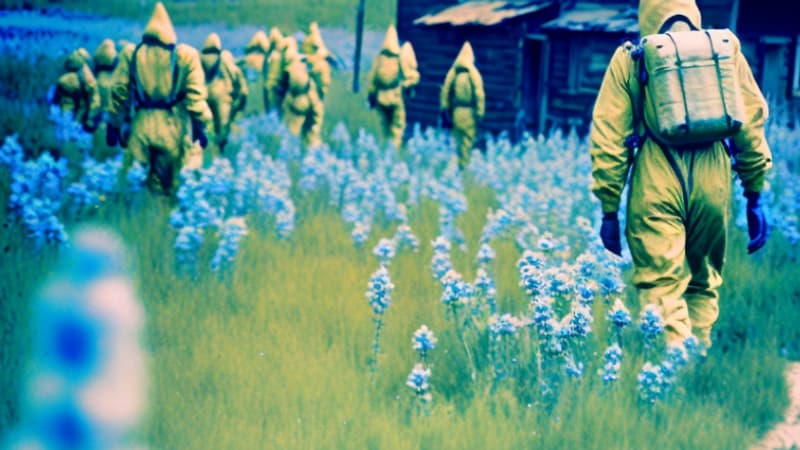A magnitude 9.1 earthquake and tsunami in Oregon in April 2001, the Blue Death in the USSR in the 1970s, or even a solar eclipse in the United States in 2012. Do these events mean nothing to you? This is normal since they never took place. However, they are well documented, supporting photos.
These false images, deceptive in their realism, are generated by artificial intelligence; especially with the Midjourney tool. And the posts are flourishing on social media. On TikTok, the account @Alt_Uchronia specializes in creating “historical fiction.” Followed by more than 38,000 people, the author of the story warns in his description: “Alternative stories from a world full of horrors.”
Behind this account is a Frenchman, Aurélien. Author of imaginary stories about a “blue plague”, a plane crash in Iceland or a false earthquake in Chile in the 1960s, he publishes videos in the form of a slide show with a text that describes the fictional scenario.
Aurélien works as a graphic designer. Science fiction fan, he writes many short stories. “I started using Midjourney to illustrate my stories,” he tells Tech & Co. He has been posting to his TikTok account since December 2022. He noted that “the Midjourney community has exploded on social media in recent months.”
“For the blue plague I was very inspired by the new fantasy Lovecraft’s Color Out of Space“, he explains, referring to the book by HP Lovecraft and published in 1927.
“Intelligence and critical thinking”
Another of his stories is inspired by a real part of history. It thus evokes the real Russian program Venera, which corresponds to all the space missions carried out by the Soviet Union during the 1960s and 1970s. A historical base used for an “alternative” scenario, which fed sequences viewed 5.6 million views on TikTok. .
This imaginary variation evokes a “secret Soviet Venera X program, released around 1990.” “The purpose of this mission has never been declassified because all data was lost during the fall of the USSR,” the sequence explains. In his slideshow, Aurélien introduces one shot, again imagined from scratch, as “the only photo of the Soviet Venera X program.” A trip during which the Soviet plane would have “captured strange shapes”.
He is also the author of a story about an earthquake in Chile. “On May 22, 1960, a powerful earthquake struck southern Chile. Reports of strange events began in the town of San Juan, which seemed to have escaped the worst of the disaster. Witnesses claimed that a huge crack had appeared in the ground near the town and that toxic gases came out of it. Some even reported having hallucinations and seeing strange creatures feeding on the bodies of the dead,” imagines the author. Photos generated by Midjourney accompany this fiction.
While widespread access to AI raises fears of a spread of misinformation, such postings can be misleading.
“A true photographic work”
The published images are rather confusingly realistic and the improvements in version 5 of Midjourney have something to do with it. “People think that all you need to do is enter a few keywords to generate an image, but it’s much more complex than that.” Aurélien explains that “a real photographic work is carried out. You have to specify the aperture, the ISO, the focal length, the type of lens and device, the light to obtain the expected result”.
On Reddit, another account specializes in producing fictional historical images. The Arctic_Chilean account is at the origin of the publications about the false solar eclipse of 2012 or the invention of the tsunami that would have hit the United States in 2001. These images involve false photos of Georges W. Bush or Barack Obama.
A full story accompanies the images: “April 3, 2001. A large earthquake occurred off the Oregon coast. About 12 minutes after the earthquake ended, northern coastal areas of the western Pacific were hit by a huge tsunami. , reaching heights of nearly 20 meters in some places, leaving more than 785,000 people homeless or in need of emergency shelter.”
Beneath these posts, netizens protest, commenting: “In 2025, people will have a lot to deal with all the misinformation. People in 2100 won’t know which parts of the story were true,” laments one user. When others get upset: “All you do is put the images, video, and audio. Most of the time, just check the source.”
Exercise critical thinking
Except that many do not take the time to read the descriptions, or to check if it is a real photograph. Could a teenager who spends time on TikTok, for example, pull out this kind of false information in a copy?
“Afterward, it’s not because they didn’t talk about it that they didn’t see it,” he qualifies. With his students, he was able to talk about deepfakes (fake photos and videos with personalities) targeting Barack Obama.
Faced with this phenomenon, he considers that his role is above all to prevent, “so that students exercise a critical spirit”, in class but also during moral and civic training “which is the most propitious moment”.
Constantly adapt to the evolution of AI
Aude Favre is president and co-founder of the FakeOff association, which brings together 80 journalists and provides media and image education in schools.
The concern is mainly about the prowess of the AI: the images are very well done and are gaining a lot of momentum on social media.
“We don’t have a silver bullet, it’s still critical to provide the tools to detect these fake images, to provide automation and reflections.” Aude Favre stresses that the attraction to these false images is still linked to mistrust of traditional media.
The main difficulty is that AI advances very quickly, education must constantly adapt to the content to which young users are exposed. “Image education concerns all ages, adolescents and adults alike,” concludes Vanessa.
Source: BFM TV


